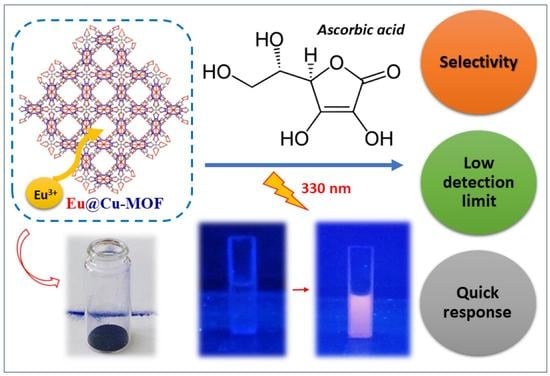Cation-Exchange in Metal-Organic Framework as a Strategy to Obtain New Material for Ascorbic Acid Detection
Abstract
:1. Introduction
2. Experimental
2.1. Materials
2.2. Synthesis of Eu@Cu-MOF
2.3. Stability test of Eu@Cu-MOF
2.4. Detection of Ascorbic Acid
2.5. Instrumentation
3. Results and Discussion
3.1. Synthesis and Characterization
3.2. Luminescent Properties of Eu@Cu-MOF
4. Conclusions
Supplementary Materials
Author Contributions
Funding
Institutional Review Board Statement
Informed Consent Statement
Data Availability Statement
Acknowledgments
Conflicts of Interest
References
- Chambial, S.; Dwivedi, S.; Shukla, K.K.; John, P.J.; Sharma, P. Vitamin C in Disease Prevention and Cure: An Overview. Indian J. Clin. Biochem. 2013, 28, 314. [Google Scholar] [CrossRef] [PubMed] [Green Version]
- Malik, M.; Narwal, V.; Pundir, C.S. Ascorbic Acid Biosensing Methods: A Review. Process Biochem. 2022, 118, 11–23. [Google Scholar] [CrossRef]
- Peng, Y.; Zhang, Y.; Ye, J. Determination of Phenolic Compounds and Ascorbic Acid in Different Fractions of Tomato by Capillary Electrophoresis with Electrochemical Detection. J. Agric. Food Chem. 2008, 56, 1838–1844. [Google Scholar] [CrossRef] [PubMed]
- Chen, H.; Li, R.; Lin, L.; Guo, G.; Lin, J.M. Determination of L-Ascorbic Acid in Human Serum by Chemiluminescence Based on Hydrogen Peroxide–Sodium Hydrogen Carbonate–CdSe/CdS Quantum Dots System. Talanta 2010, 81, 1688–1696. [Google Scholar] [CrossRef] [PubMed]
- Suntornsuk, L.; Gritsanapun, W.; Nilkamhank, S.; Paochom, A. Quantitation of Vitamin C Content in Herbal Juice Using Direct Titration. J. Pharm. Biomed. Anal. 2002, 28, 849–855. [Google Scholar] [CrossRef]
- May, B.M.M.; Parani, S.; Oluwafemi, O.S. Detection of Ascorbic Acid Using Green Synthesized AgInS2 Quantum Dots. Mater. Lett. 2019, 236, 432–435. [Google Scholar] [CrossRef]
- Ferreira, D.C.M.; Giordano, G.F.; Soares, C.C.D.S.P.; De Oliveira, J.F.A.; Mendes, R.K.; Piazzetta, M.H.; Gobbi, A.L.; Cardoso, M.B. Optical Paper-Based Sensor for Ascorbic Acid Quantification Using Silver Nanoparticles. Talanta 2015, 141, 188–194. [Google Scholar] [CrossRef]
- Park, H.W.; Alama, S.M.; Lee, S.H.; Karim, M.M.; Wabaidur, S.M.; Kang, M.; Choi, J.H. Optical Ascorbic Acid Sensor Based on the Fluorescence Quenching of Silver Nanoparticles. Luminescence 2009, 24, 367–371. [Google Scholar] [CrossRef]
- Kumar, S.; Singh, R.; Yang, Q.; Cheng, S.; Zhang, B.; Kaushik, B.K. Highly Sensitive, Selective and Portable Sensor Probe Using Germanium-Doped Photosensitive Optical Fiber for Ascorbic Acid Detection. IEEE Sens. J. 2021, 21, 62–70. [Google Scholar] [CrossRef]
- Pisoschi, A.M.; Pop, A.; Serban, A.I.; Fafaneata, C. Electrochemical Methods for Ascorbic Acid Determination. Electrochim. Acta 2014, 121, 443–460. [Google Scholar] [CrossRef]
- Mazzara, F.; Patella, B.; Aiello, G.; O’Riordan, A.; Torino, C.; Vilasi, A.; Inguanta, R. Electrochemical Detection of Uric Acid and Ascorbic Acid Using R-GO/NPs Based. Sensors Electrochim. Acta 2021, 388, 138652. [Google Scholar] [CrossRef]
- Dhara, K.; Debiprosad, R.M. Review on Nanomaterials-Enabled Electrochemical Sensors for Ascorbic Acid Detection. Anal. Biochem. 2019, 586, 113415. [Google Scholar] [CrossRef]
- McGrath, M.J.; Scanaill, C.N. Sensor Technologies: Healthcare, Wellness, and Environmental Applications; Springer Nature: Berlin, Germany, 2013; ISBN 9781430260141. [Google Scholar]
- Yue, D.; Zhao, D.; Zhang, J.; Zhang, L.; Jiang, K.; Zhang, X.; Cui, Y.; Yang, Y.; Chen, B.; Qian, G. A Luminescent Cerium Metal-Organic Framework for the Turn-on Sensing of Ascorbic Acid. Chem. Commun. 2017, 53, 11221–11224. [Google Scholar] [CrossRef]
- Li, X.; Lin, R.; Hou, J.; Wang, L. Sintering of Metal-Organic Frameworks. Cell Rep. Phys. Sci. 2022, 3, 100932. [Google Scholar] [CrossRef]
- Xu, Q.; Kitagawa, H. MOFs: New Useful Materials–A Special Issue in Honor of Prof. Susumu Kitagawa. Adv. Mater. 2018, 30, 1803613. [Google Scholar] [CrossRef] [Green Version]
- Zhang, J.P.; Liao, P.Q.; Zhou, H.L.; Lin, R.B.; Chen, X.M. Single-Crystal X-Ray Diffraction Studies on Structural Transformations of Porous Coordination Polymers. Chem. Soc. Rev. 2014, 43, 5789–5814. [Google Scholar] [CrossRef]
- Elsabawy, K.M.; Fallatah, A.M. Microwave Assisted Synthesis and Molecular Structure Visualization of Ultrahigh Surface Area Ni-6,6′-Dibromo-Indigo Coordinated Polymeric MOFs Stabilized via Hydrogen Bonding. Inorg. Chem. Commun. 2018, 92, 78–83. [Google Scholar] [CrossRef]
- Liang, H.; Jiao, X.; Li, C.; Chen, D. Flexible Self-Supported Metal-Organic Framework Mats with Exceptionally High Porosity for Enhanced Separation and Catalysis. J. Mater. Chem. A 2018, 6, 334–341. [Google Scholar] [CrossRef]
- Zheng, J.; Cui, X.; Yang, Q.; Ren, Q.; Yang, Y.; Xing, H. Shaping of Ultrahigh-Loading MOF Pellet with a Strongly Anti-Tearing Binder for Gas Separation and Storage. Chem. Eng. J. 2018, 354, 1075–1082. [Google Scholar] [CrossRef]
- Mallakpour, S.; Nikkhoo, E.; Hussain, C.M. Application of MOF Materials as Drug Delivery Systems for Cancer Therapy and Dermal Treatment. Coord. Chem. Rev. 2022, 451, 214262. [Google Scholar] [CrossRef]
- Rojas, S.; Horcajada, P. Understanding the Incorporation and Release of Salicylic Acid in Metal-Organic Frameworks for Topical Administration. Eur. J. Inorg. Chem. 2021, 2021, 1325–1331. [Google Scholar] [CrossRef]
- Ling, D.; Li, H.; Xi, W.; Wang, Z.; Bednarkiewicz, A.; Dibaba, S.T.; Shi, L.; Sun, L. Heterodimers Made of Metal-Organic Frameworks and Upconversion Nanoparticles for Bioimaging and PH-Responsive Dual-Drug Delivery. J. Mater. Chem. B 2020, 8, 1316–1325. [Google Scholar] [CrossRef] [PubMed]
- Niu, Q.; Jin, M.; Liu, G.; Lv, Z.; Si, C.; Han, H. Bilayer MOF@MOF and MoOx Species Functionalization to Access Prominent Stability and Selectivity in Cascade-Selective Biphase Catalysis. Mol. Catal. 2021, 513, 111818. [Google Scholar] [CrossRef]
- Alsalahi, W.; Augustyniak, A.W.; Tylus, W.; Trzeciak, A.M. New Palladium–ZrO2 Nano-Architectures from Thermal Transformation of UiO-66-NH2 for Carbonylative Suzuki and Hydrogenation Reactions. Chem. Eur. J. 2022, 28, e202103538. [Google Scholar] [CrossRef] [PubMed]
- Tang, Y.J.; Zheng, H.; Wang, Y.; Zhang, W.; Zhou, K. Laser-Induced Annealing of Metal-Organic Frameworks on Conductive Substrates for Electrochemical Water Splitting. Adv. Funct. Mater. 2021, 31, 2102648. [Google Scholar] [CrossRef]
- Zheng, M.; Xu, L.; Chen, C.; Labiadh, L.; Yuan, B.; Fu, M.L. MOFs and GO-Based Composites as Deliberated Materials for the Adsorption of Various Water Contaminants. Sep. Purif. Technol. 2022, 294, 121187. [Google Scholar] [CrossRef]
- Zhang, W.; Li, R.; Zheng, H.; Bao, J.; Tang, Y.; Zhou, K. Laser-Assisted Printing of Electrodes Using Metal-Organic Frameworks for Micro-Supercapacitors. Adv. Funct. Mater. 2021, 31, 2009057. [Google Scholar] [CrossRef]
- Mahata, P.; Mondal, S.K.; Singha, D.K.; Majee, P. Luminescent Rare-Earth-Based MOFs as Optical Sensors. Dalton Trans. 2017, 46, 301–328. [Google Scholar] [CrossRef]
- Zhao, Y.; Li, D. Lanthanide-Functionalized Metal-Organic Frameworks as Ratiometric Luminescent Sensors. J. Mater. Chem. C 2020, 8, 12739–12754. [Google Scholar] [CrossRef]
- Xia, Y.D.; Sun, Y.Q.; Cheng, Y.; Xia, Y.; Yin, X.B. Rational Design of Dual-Ligand Eu-MOF for Ratiometric Fluorescence Sensing Cu2+ Ions in Human Serum to Diagnose Wilson’s Disease. Anal. Chim. Acta 2022, 1204, 339731. [Google Scholar] [CrossRef]
- Wu, N.; Guo, H.; Wang, X.; Sun, L.; Zhang, T.; Peng, L.; Yang, W. A Water-Stable Lanthanide-MOF as a Highly Sensitive and Selective Luminescence Sensor for Detection of Fe3+ and Benzaldehyde. Colloids Surf. A Physicochem. Eng. Asp. 2021, 616, 126093. [Google Scholar] [CrossRef]
- Liu, S.; Liu, M.; Guo, M.; Wang, Z.; Wang, X.; Cui, W.; Tian, Z. Development of Eu-Based Metal-Organic Frameworks (MOFs) for Luminescence Sensing and Entrapping of Arsenate Ion. J. Lumin. 2021, 236, 118102. [Google Scholar] [CrossRef]
- Wang, C.Y.; Wang, C.C.; Zhang, X.W.; Ren, X.Y.; Yu, B.; Wang, P.; Zhao, Z.X.; Fu, H. A New Eu-MOF for Ratiometrically Fluorescent Detection toward Quinolone Antibiotics and Selective Detection toward Tetracycline Antibiotics. Chin. Chem. Lett. 2022, 33, 1353–1357. [Google Scholar] [CrossRef]
- Yi, K.; Zhang, L. Designed Eu(III)-Functionalized Nanoscale MOF Probe Based on Fluorescence Resonance Energy Transfer for the Reversible Sensing of Trace Malachite Green. Food Chem. 2021, 354, 129584. [Google Scholar] [CrossRef]
- Zhao, X.Y.; Wang, J.; Hao, H.G.; Yang, H.; Yang, Q.S.; Zhao, W.Y. A Water-Stable Europium-MOF Sensor for the Selective, Sensitive Ratiometric Fluorescence Detection of Anthrax Biomarker. Microchem. J. 2021, 166, 106253. [Google Scholar] [CrossRef]
- Zheng, X.; Fan, R.; Song, Y.; Xing, K.; Wang, P.; Yang, Y. Dual-Emitting Eu(III)-Cu(II) Heterometallic-Organic Framework: Simultaneous, Selective, and Sensitive Detection of Hydrogen Sulfide and Ascorbic Acid in a Wide Range. ACS Appl. Mater. Interfaces 2018, 10, 32698–32706. [Google Scholar] [CrossRef]
- Yuan, Y.Y.; Yang, S.L.; Zhang, C.X.; Wang, Q.L. A New Europium Metal-Organic Framework with Both High Proton Conductivity and Highly Sensitive Detection of Ascorbic Acid. CrystEngComm 2018, 20, 6989–6994. [Google Scholar] [CrossRef]
- Li, S.; Gao, Y.; Li, N.; Ge, L.; Bu, X.; Feng, P. Transition Metal-Based Bimetallic MOFs and MOF-Derived Catalysts for Electrochemical Oxygen Evolution Reaction. Energy Environ. Sci. 2021, 14, 1897–1927. [Google Scholar] [CrossRef]
- Zhang, Y.; Liu, S.; Zhao, Z.S.; Wang, Z.; Zhang, R.; Liu, L.; Han, Z.B. Recent Progress in Lanthanide Metal-Organic Frameworks and Their Derivatives in Catalytic Applications. Inorg. Chem. Front. 2021, 8, 590–619. [Google Scholar] [CrossRef]
- Maczka, M.; Gagor, A.; Ptak, M.; Stefańska, D.; Macalik, L.; Pikul, A.; Sieradzki, A. Structural, Phonon, Magnetic and Optical Properties of Novel Perovskite-like Frameworks of TriBuMe[M(Dca)3] (TriBuMe = Tributylmethylammonium; Dca = Dicyanamide; M = Mn2+, Fe2+, Co2+, Ni2+). Dalton Trans. 2019, 48, 13006–13016. [Google Scholar] [CrossRef]
- Ptak, M.; Gagor, A.; Sieradzki, A.; Bondzior, B.; Dereń, P.; Ciupa, A.; Trzebiatowska, M.; Maczka, M. The Effect of K+ Cations on the Phase Transitions, and Structural, Dielectric and Luminescence Properties of [Cat][K0.5Cr0.5(HCOO)3], Where Cat Is Protonated Dimethylamine or Ethylamine. Phys. Chem. Chem. Phys. 2017, 19, 12156–12166. [Google Scholar] [CrossRef] [PubMed] [Green Version]
- Procopio, E.Q.; Linares, F.; Montoro, C.; Colombo, V.; Maspero, A.; Barea, E.; Navarro, J.A.R. Cation-Exchange Porosity Tuning in Anionic Metal-Organic Frameworks for the Selective Separation of Gases and Vapors and for Catalysis. Angew. Chem. Int. Ed. 2010, 49, 7308–7311. [Google Scholar] [CrossRef] [PubMed]
- Ghazalli, N.F.; Yuliati, L.; Lintang, H.O. Molecular Self-Assembly of Group 11 Pyrazolate Complexes as Phosphorescent Chemosensors for Detection of Benzene. IOP Conf. Ser. Mater. Sci. Eng. 2018, 299, 012029. [Google Scholar] [CrossRef]
- Phuong, N.T.; Buess-Herman, C.; Thom, N.T.; Nam, P.T.; Lam, T.D.; Thanh, D.T.M. Synthesis of Cu-BTC, from Cu and Benzene-1,3,5-Tricarboxylic Acid (H3BTC), by a Green Electrochemical Method. Green Process. Synth. 2016, 5, 537–547. [Google Scholar] [CrossRef]
- Hadjiivanov, K.I.; Panayotov, D.A.; Mihaylov, M.Y.; Ivanova, E.Z.; Chakarova, K.K.; Andonova, S.M.; Drenchev, N.L. Power of Infrared and Raman Spectroscopies to Characterize Metal-Organic Frameworks and Investigate Their Interaction with Guest Molecules. Chem. Rev. 2021, 121, 1286–1424. [Google Scholar] [CrossRef]
- Liu, J.; Cheng, M.L.; Yu, L.L.; Chen, S.C.; Shao, Y.L.; Liu, Q.; Zhai, C.W.; Yin, F.X. Three Metal Complexes Derived from 3-Methyl-1H-Pyrazole-4-Carboxylic Acid: Synthesis, Crystal Structures, Luminescence and Electrocatalytic Properties. RSC Adv. 2016, 6, 52040–52047. [Google Scholar] [CrossRef]
- Nivetha, R.; Sajeev, A.; Paul, A.M.; Gothandapani, K.; Gnanasekar, S.; Bhardwaj, P.; Jacob, G.; Sellappan, R.; Raghavan, V.; Chandar, K.N. Cu Based Metal Organic Framework (Cu-MOF) for Electrocatalytic Hydrogen Evolution Reaction. Mater. Res. Express 2020, 7, 114001. [Google Scholar] [CrossRef]
- Sing, K.S.W.; Everett, D.H.; Haul, R.A.W.; Moscou, L.; Pierotti, R.A.; Rouquerol, J.; Siemieniewska, T. Reporting Physisorption Data for Gas/Solid Systems with Special Reference to the Determination of Surface Area and Porosity (Recommendations 1984). Pure Appl. Chem. 1985, 57, 603–619. [Google Scholar] [CrossRef]
- Thommes, M.; Kaneko, K.; Neimark, A.V.; Olivier, J.P.; Rodriguez-Reinoso, F.; Rouquerol, J.; Sing, K.S.W. Physisorption of Gases, with Special Reference to the Evaluation of Surface Area and Pore Size Distribution (IUPAC Technical Report). Pure Appl. Chem. 2015, 87, 1051–1069. [Google Scholar] [CrossRef] [Green Version]
- Lowell, S.; Shields, J.E.; Thomas, M.A.; Thommes, M. Characterization of Porous Solids and Powders: Surface Area, Pore Size, and Density; Springer Science+Business Media LLC.: Berlin, Germany, 2004; pp. 11–14. [Google Scholar]
- Szyszka, K.; Targońska, S.; Lewińska, A.; Watras, A.; Wiglusz, R.J. Quenching of the Eu3+ Luminescence by Cu2+ Ions in the Nanosized Hydroxyapatite Designed for Future Bio-Detection. Nanomaterials 2021, 11, 464. [Google Scholar] [CrossRef]
- Guo, C.; Jin, Q.; Wang, Y.; Ding, B.; Li, Y.; Huo, J.; Zhao, X. Developing a Unique Metal-Organic Framework-{[Cd(Abtz)2(NCS)]·(ClO4)}n (Abtz = 1-(4-Aminobenzyl)-1,2,4-Triazole) as Fluorescent Probe for Highly Selective and Sensitive Detection of Ascorbic Acid in Biological Liquid. Sens. Actuators B Chem. 2016, 234, 184–191. [Google Scholar] [CrossRef]
- Zhang, J.W.; Zhang, H.T.; Du, Z.Y.; Wang, X.; Yu, S.H.; Jiang, H.L. Water-Stable Metal-Organic Frameworks with Intrinsic Peroxidase-like Catalytic Activity as a Colorimetric Biosensing Platform. Chem. Commun. 2014, 50, 1092–1094. [Google Scholar] [CrossRef]
- Zhang, J.P.; Lin, Y.Y.; Huang, X.C.; Chen, X.M. Copper(I) 1,2,4-Triazolates and Related Complexes: Studies of the Solvothermal Ligand Reactions, Network Topologies, and Photoluminescence Properties. J. Am. Chem. Soc. 2005, 127, 5495–5506. [Google Scholar] [CrossRef]
- Zhang, X.; Hu, Q.; Xia, T.; Zhang, J.; Yang, Y.; Cui, Y.; Chen, B.; Qian, G. Turn-on and Ratiometric Luminescent Sensing of Hydrogen Sulfide Based on Metal-Organic Frameworks. ACS Appl. Mater. Interfaces 2016, 8, 32259–32265. [Google Scholar] [CrossRef]
- Fritzsche, J.; Ettlinger, R.; Grzywa, M.; Jantz, S.G.; Kalytta-Mewes, A.; Bunzen, H.; Höppe, H.A.; Volkmer, D. CFA-15–a Perfluorinated Metal-Organic Framework with Linear 1-D CuII-Chains Containing Accessible Unsaturated, Reactive Metal Centres. Dalton Trans. 2019, 48, 15236–15246. [Google Scholar] [CrossRef]
- Arakawa, T.; Akamine, M. Determination of Transition Metal Irons Based on Quenching of the Rare Earth Luminescence. Sens. Actuators B Chem. 2003, 91, 252–255. [Google Scholar] [CrossRef]
- Hanaki, A. Copper-Catalyzed Oxidation of Ascorbic Acid. Chem. Pharm. Bull. 1969, 17, 1839–1846. [Google Scholar] [CrossRef] [Green Version]
- Lavareda, G.; De Carvalho, C.N.; Ferraria, A.M.; Botelho Do Rego, A.M.; Amaral, A. P-Type Cuox Thin Films by RF-Plasma Enhanced Reactive Thermal Evaporation: Influence of RF-Power Density. J. Nanosci. Nanotechnol. 2012, 12, 6754–6757. [Google Scholar] [CrossRef]
- Swadźba-Kwaśny, M.; Chancelier, L.; Ng, S.; Manyar, H.G.; Hardacre, C.; Nockemann, P. Facile in Situ Synthesis of Nanofluids Based on Ionic Liquids and Copper Oxide Clusters and Nanoparticles. Dalton Trans. 2011, 41, 219–227. [Google Scholar] [CrossRef]

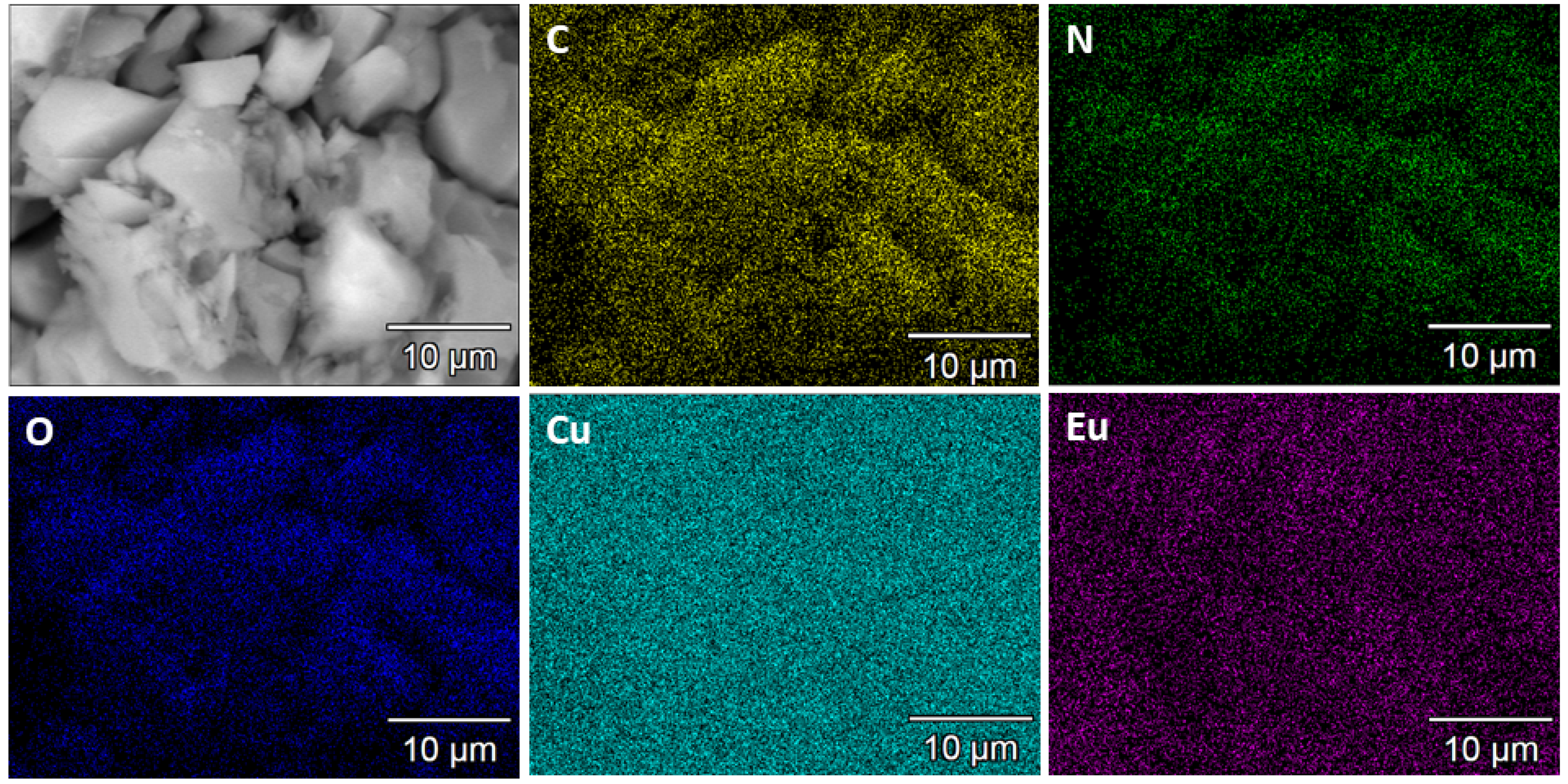
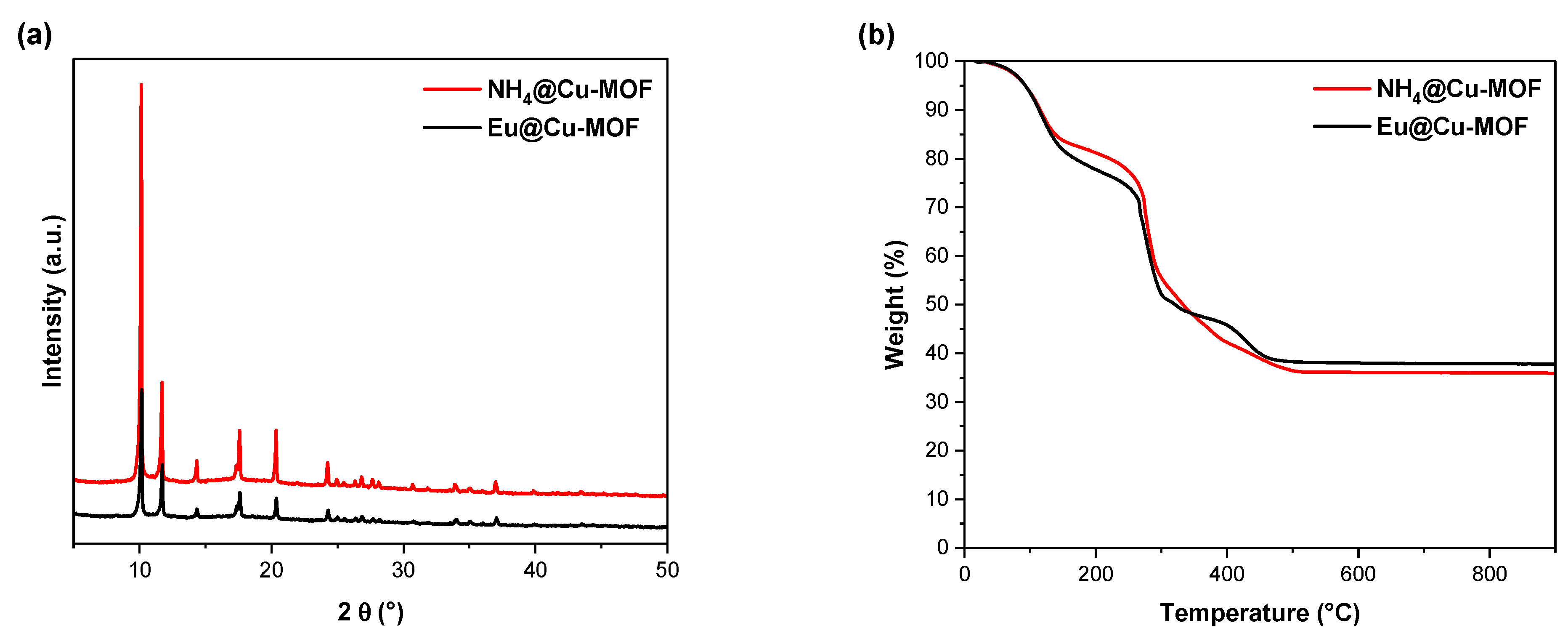


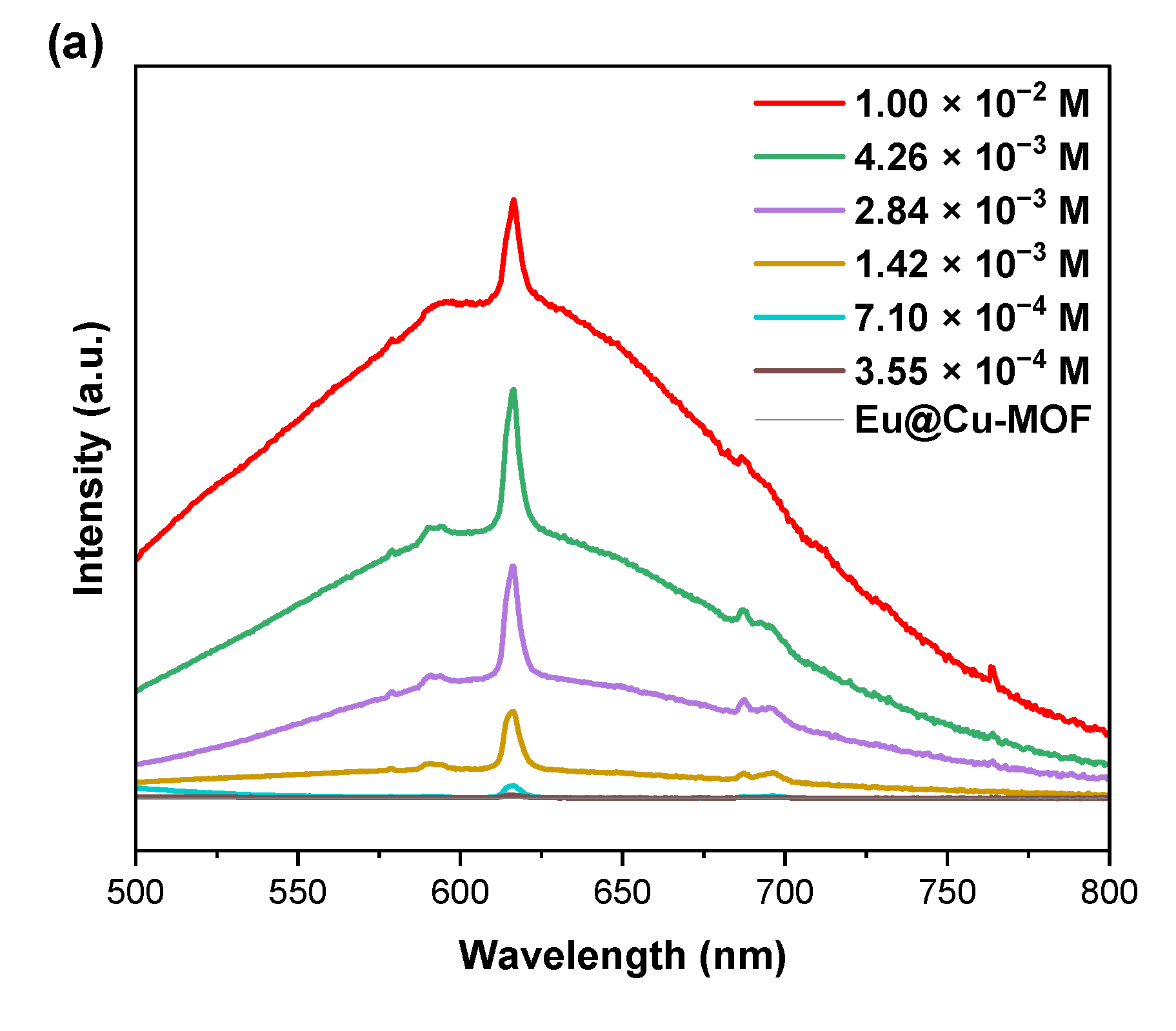


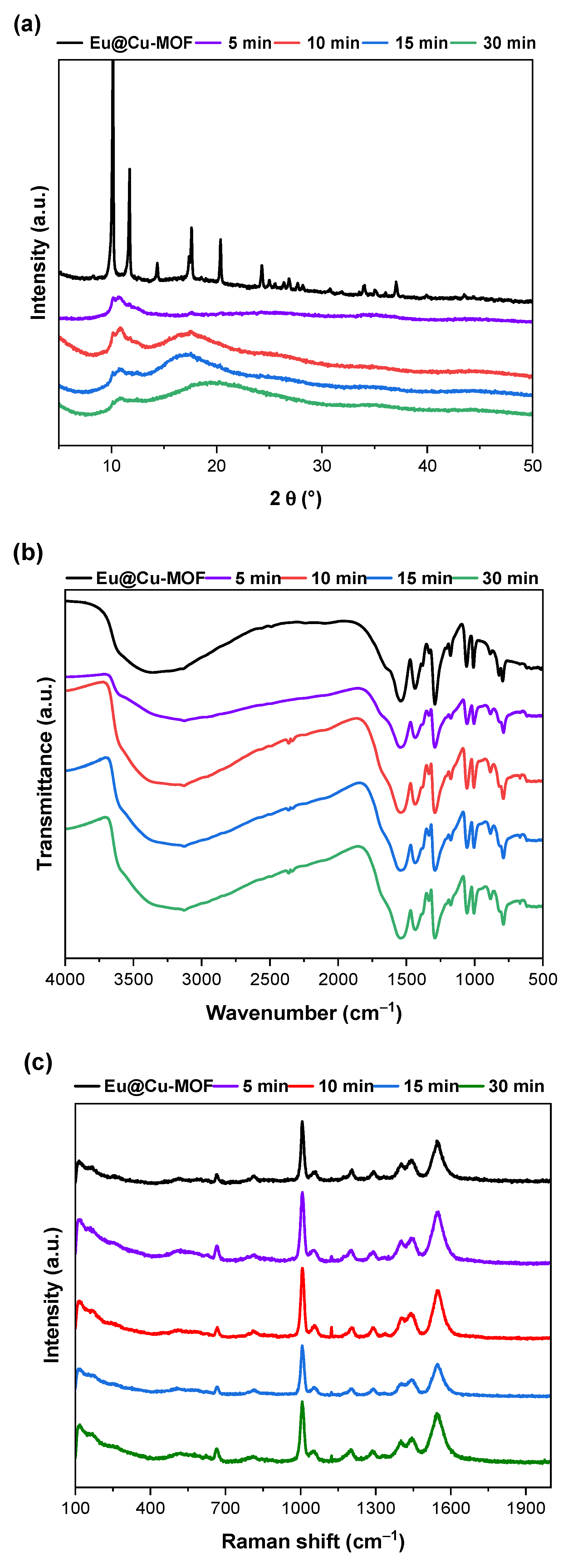
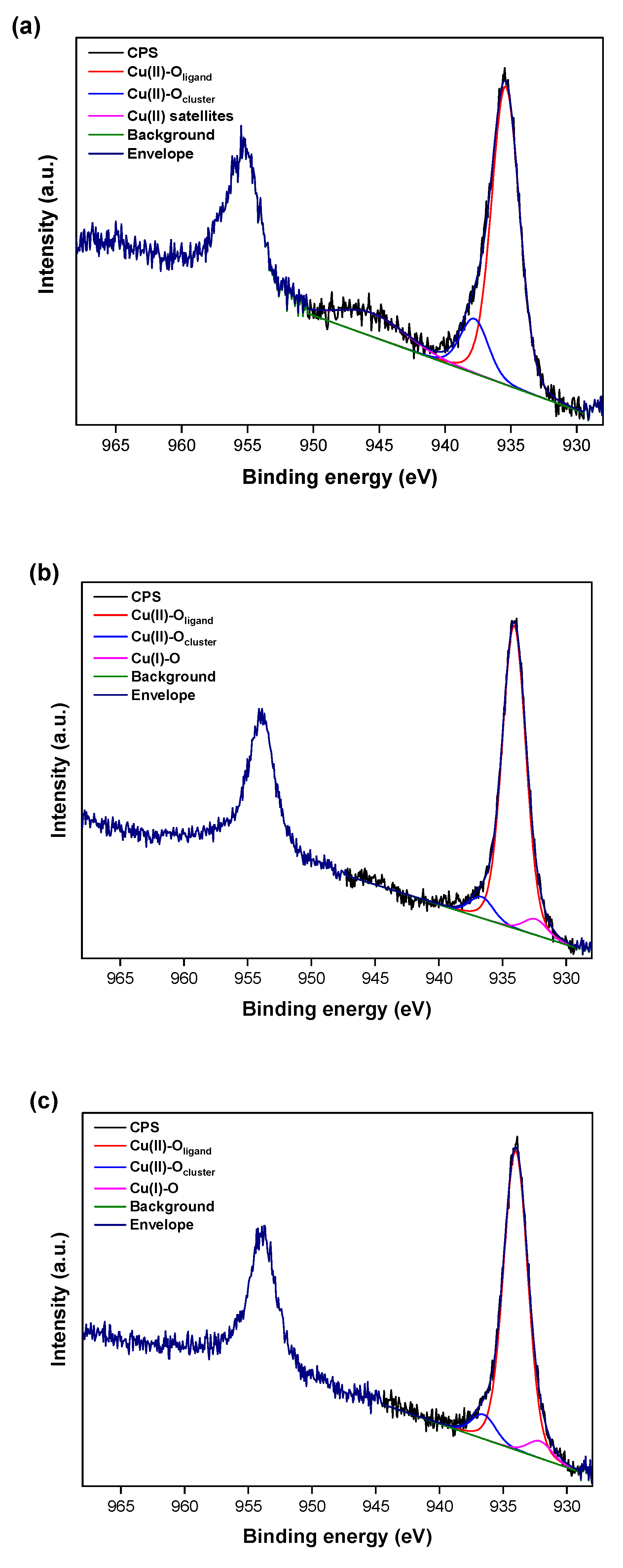
Publisher’s Note: MDPI stays neutral with regard to jurisdictional claims in published maps and institutional affiliations. |
© 2022 by the authors. Licensee MDPI, Basel, Switzerland. This article is an open access article distributed under the terms and conditions of the Creative Commons Attribution (CC BY) license (https://creativecommons.org/licenses/by/4.0/).
Share and Cite
Bodylska, W.; Fandzloch, M.; Szukiewicz, R.; Lukowiak, A. Cation-Exchange in Metal-Organic Framework as a Strategy to Obtain New Material for Ascorbic Acid Detection. Nanomaterials 2022, 12, 4480. https://doi.org/10.3390/nano12244480
Bodylska W, Fandzloch M, Szukiewicz R, Lukowiak A. Cation-Exchange in Metal-Organic Framework as a Strategy to Obtain New Material for Ascorbic Acid Detection. Nanomaterials. 2022; 12(24):4480. https://doi.org/10.3390/nano12244480
Chicago/Turabian StyleBodylska, Weronika, Marzena Fandzloch, Rafał Szukiewicz, and Anna Lukowiak. 2022. "Cation-Exchange in Metal-Organic Framework as a Strategy to Obtain New Material for Ascorbic Acid Detection" Nanomaterials 12, no. 24: 4480. https://doi.org/10.3390/nano12244480
APA StyleBodylska, W., Fandzloch, M., Szukiewicz, R., & Lukowiak, A. (2022). Cation-Exchange in Metal-Organic Framework as a Strategy to Obtain New Material for Ascorbic Acid Detection. Nanomaterials, 12(24), 4480. https://doi.org/10.3390/nano12244480







